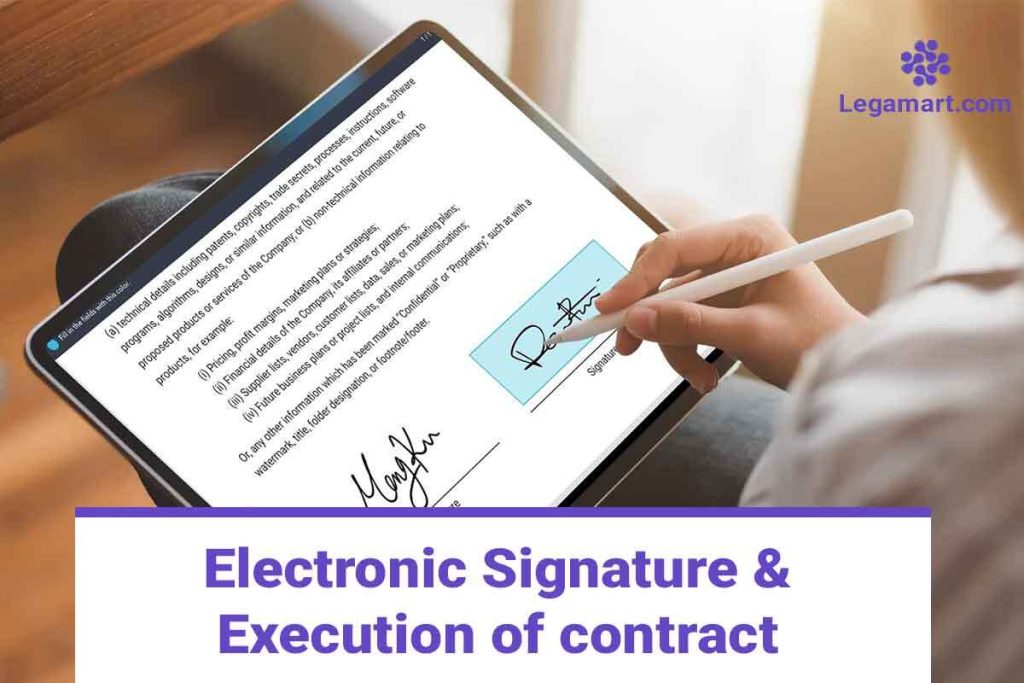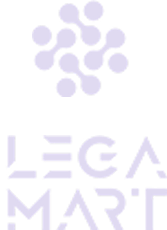- Introduction
- Electronic Contracts
- Types of Electronic Signature
- Requirements for an Electronic Signature
- Benefits of Electronic Signature
- Issues with Electronic Signatures
- Applications of Electronic Signature
- Documents that can be signed through electronic signature
- Documents that cannot be signed through an e-signatures
- How do you electronically sign a document?
- What makes an e-signature valid?
- Difference Between a Digital and Electronic Signature
- Enforceability of Electronic Signature
- Electronic Signature as Evidence in Court
- Electronic Signature under Various Laws and Regulations
- Electronic Signatures in the European Union
- E-contracts and E-signatures in a Post-Covid Era
- Replacement of Wet Ink Signature with E-signatures
- Conclusion
- Frequently Asked Questions (FAQs)
Introduction
The COVID-19 pandemic resulted in changes to the operations of businesses and companies. It changed how people used to work, like going to the office or conducting regular face-to-face meetings. In the Post COVID-19 era, working has shifted to remote work. People faced many problems in adapting to this new way of working.
One such problem was the signing of contracts. Earlier parties used to meet at a specified location and consent to the terms by signing a physical copy of the contract, and then each party would have a copy of the contract with them. Since COVID-19 brought restrictions on the gathering of the public, it wasn’t easy to sign a contract physically.
Therefore, companies started using E-contracts and E-signatures. Due to this, e-Signature transactions have ballooned from 89 million to 754 million in the last few years. An electronic signature is used to show acceptance of the terms of a digital contract or agreement.
Without signatures and the execution of contracts, companies face a lot of difficulties conducting business on digital platforms. E-contracts and E-signatures in the post-covid era have changed the traditional behaviour of entering into contracts or agreements. This article will discuss the enforceability of electronic signatures and the execution of contracts.
Electronic Contracts
Due to technological advances, electronic contracts provide a more significant benefit, saving people time, cost, and money. The entire process of drafting and executing electronic contracts can take place online. Execution is made easy through the e-signing of contracts. E-contract has the exact requirements as that of a contract.
Types of Electronic Contracts
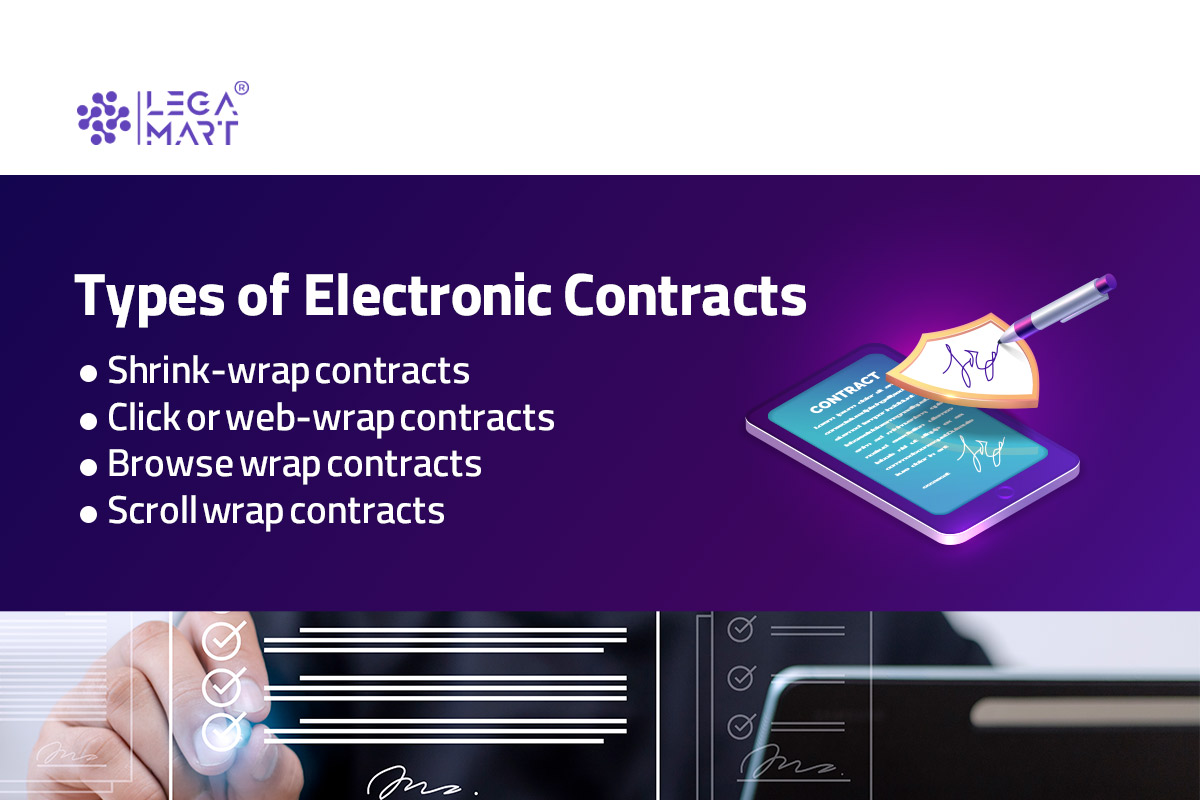
Electronic contracts can be of different forms mentioned below:
Shrink-wrap contracts
Such contracts are in the form of licensing agreements for software purchases. It contains specific terms and conditions related to the product or purchase, such as product pricing, warranties, limitations, and licenses. A unique feature of this contract is that you can’t see the terms until the package has been accepted.
Click or web-wrap contracts
It is a web-based contract that requires the user’s approval through the “I Accept” or “I Agree” button. The user has to abide by the terms and conditions before using the software or product.
Browse wrap contracts
It is a contract entered into while browsing the website. Generally, the contract is displayed as a hyperlink showing the terms and conditions of using the website. It binds the website’s user to the usage of the website.
Scroll wrap contracts
It means that the contract needs to be scrolled down, implying that the user has read all the terms and conditions of the agreement.
The end step for enforcing electronic contracts is putting e-signatures on such contracts. Such e-signing of a contract can happen in various ways, such as through clicking on the place of your order button while shopping or signing an agreement electronically. Before the e-signing of a contract occurs, the electronic contract should be verified by both parties.
Types of Electronic Signature
The European Union (EU) eIDAS regulation (electronic identification and trust services) mentions three types of E-signatures. Below are the mentioned e-signatures used for the E-signing of contracts:
Simple electronic signature
The eIDAS regulation defines an e-signature as “data in electronic form which is attached to or logically associated with other data in electronic form and used by the signatory to sign.” Examples of simple e-signatures include scanned signatures or checkboxes mentioning the I Accept button. E-signing is not subject to verification of the signer’s identity or authenticity. No external hardware is required while using this signature.
Advanced e-signatures
These signatures require additional verification for usage. They must be uniquely linked to the signatory. A Certificate Authority (CA) issues certificates that can authenticate the advanced e-signatures (AES). AES uses asymmetric cryptography to secure the signature. The signature is created under the sole control of the signatory. AES will be rendered invalid if the data is changed. One-Time-Password must be used to verify the identity of the signatory.
Qualified electronic signature
It is an advanced e-signature with much higher security. Multi-step authentication is used for this signature for authentication of the signatory. It relies on a Qualified digital certificate issued by a Qualified Trust Service Provider (QTSP). It comes with a card reader so that the signatory’s identity can be verified.
If you are unsure which e-signature to use, consult lawyers at LegaMart, who can walk you through the process. LegaMart offers various services, such as case reviews, advocacy, and more. It also helps to solve issues in electronic signatures and the valid execution of contracts.
Requirements for an Electronic Signature
For the E-signing of a contract, the e-signatures must be reliable and valid. The following are the requirements which must be adhered to while E-signing of agreement:
- The signature must be unique and valid, found only on the person signing the contract.
- The person signing the contract must have ownership of their data to ensure a secure, authentic, and reliable.
- Before you sign the contract, ensure you’ve inspected the chain of steps observed during the E-signing of the contract.
- The authenticity of the signatory must be verified. Every document needs two-step authentication for this object.
- The intent of the signer should be shown electronically.
- They must be retained by both parties signing the contract.
- Third-party software should be used to secure the e-signatures so that it cannot be tampered with after signing.
Benefits of Electronic Signature
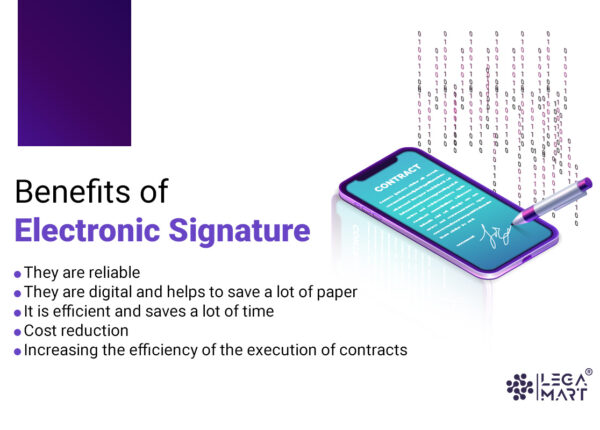
Many software available on the internet helps to manage electronic signatures and valid execution of contracts, saving time and cost for the parties involved in the contract. Other benefits which are available with an e-signatures are listed below:
- They are reliable.
- They are digital and helps to save a lot of paper
- It is efficient and saves a lot of time
- Cost reduction
- Increasing the efficiency of the execution of contracts
Issues with Electronic Signatures
Although technology has advanced, many issues still exist in e-signatures and the valid execution of contracts. Various risks are associated with e-signatures, such as
- Risk of fraud – Anybody can forge the signature since websites can be hacked or compromised.
- Risk of unauthorized signature – It is challenging to authorize the signatory.
- Risk of loss and destruction – There is no way of guaranteeing the security of your online signatures. A document containing the E-signature can be tampered with very quickly.
- Risk of non-compliance with laws – Some documents need a notary or stamping, and very few countries have accepted online stamping, even during the pandemic.
- Reliability of Certification Authority – Even though the certifying authority follows all the regulations, there is no guarantee about the credibility of the certificates issued.
Applications of Electronic Signature
They are used by various entities mentioned below but are not limited to:
- Financial Institutions such as banks
- Companies and Government
- Human Resources
Documents that can be signed through electronic signature
Electronic signatures can be used to sign the following documents:
- Offer letters
- Sales contracts
- Permission slips
- Rental/lease agreements
- Liability waivers
- Financial documents
Documents that cannot be signed through an e-signatures

The following documents cannot be signed with the help of an e-signature:
- Wills and codicils
- Court orders and notices
- Documents related to a family matter
- Notices regarding cancellation or termination of health insurance benefits
How Do Electronic Signatures Work in a Digital Contract?
Electronic signatures work much like handwritten ones, but they are digital. When both parties agree to the contract terms, they sign it electronically.
Here is how it happens: When you sign digitally, the system creates a private and public key. You keep the private key, which is like a secret code. The system uses math to lock up your signature with this code, creating a unique digital ID for it. If the system can’t unlock a signature with this ID, it’s not valid.
In the eyes of the law, only a valid electronic signature, one that matches the digital key the system made, is accepted. Each signature has its own unique key, ensuring its authenticity
How Do You Electronically Sign a Document?
There have been many modes of e-signatures available in the market, including but not limited to HelloSign, AdobeSign, DocuSign, SignNow, etc. Most of these platforms help in providing basic signing functionality at minimum entry-level pricing. Automation platforms such as Juro also provide a complete contract lifecycle depth, thereby automating the creation of contracts at scale through approval workflows, in-browser negotiation, native eSignature, and post-signature tracking and analytics. This can be the preference of larger teams or mid-markets, which have a higher contract volume.
It is also possible to add your e-signatures within the native document format itself through the scanning of a signature or directly adding it within the document. The three most common formats are PDF, Word, and Google Docs.
How to Add Electronic Signatures to PDF?
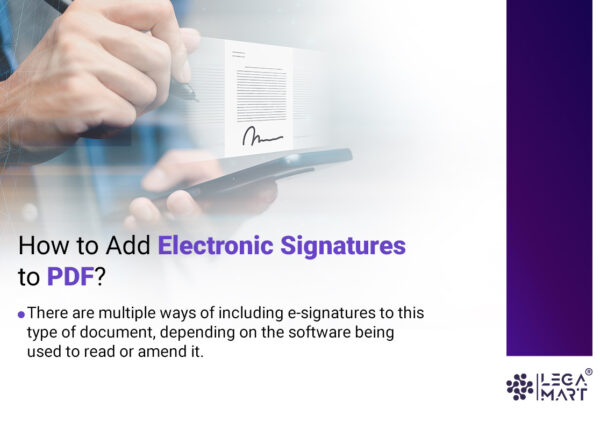
There are multiple ways of including e-signatures to this type of document, depending on the software being used to read or amend it.
- Adding signatures using MacOS – when opening PDFs on a desktop or mac, they open in Preview by default. Therefore, to add the signature to the document, choose ‘Tools’ from the menu, then ‘Annotate’ and then ‘Signature’. Through the option of ‘Manage Signatures’, you are able to add different signature options to the menu by drawing them through a trackpad or mouse. Once you select the signature you wish to add, you can drag it to the right place.
This is normally not preferred by businesses, considering it doesn’t have the necessary security properties that businesses wish to incorporate during the conclusion of contracts, such as a valid authentication.
- Adding signatures using iOS – To digitally sign your PDF using iPad or iPhone, you first need to open your document using the ‘Files’ app and then hit the ‘Plus’ button at the bottom right to annotate it. Then you choose ‘Signature’, which shall be created for you.
- Adding signatures using Android – You can only have an e-signature when you have downloaded an external application, such as Adobe Reader or SignEasy.
How to add electronic signatures to Word documents?
You need to select where you want to insert your signature to appear. From the ‘Insert’ tab, choose ‘Text, then ‘Signature List’, then finally ‘Microsoft Office Signature Line’. You can set up the signature by entering the signing party’s name.
How to add electronic signatures to Google Doc?
The signing functionality within Google Docs is limited in nature. Without any third-party software, you just need to select ‘Insert’ from the menu, choose ‘Drawing’, then navigate to ‘Scribble’ and draw an approximation of a signature on the subsequent screen.
What Makes an E-signature Valid?
The following factors make your e-signatures valid for any business:
- Timestamp – When you fully sign a contract, a digital timestamp with your e-signatures makes it easier for the company’s legal team to keep a check on the time and dates.
- Security – Signatures that may be stored on Cloud, are naturally less likely to be damaged, misused, or lost.
- An audit trail – To open a document and find the exact person who signed the document becomes essential for tracking purposes. Through recent native tools, you may now get access to the full audit trail of negotiations and edits, which shall help your business to manage version control.
How to Make Sure an E-Signature is Legal and Valid?
Ensuring the legality and validity of electronic signatures is a crucial aspect of modern business transactions. By following specific steps, businesses can safeguard the integrity of e-signatures and maintain the trustworthiness of their digital contracts:
- Safeguard the E-Signature: Use a reputable e-signature software provider, particularly one based on Public Key Infrastructure (PKI) system software. This type of software is reliable for capturing the signature within the contract and protects the signed document with an unbreakable digital key.
- Confirm Intent: Ensure both parties genuinely intend to sign the document electronically. To do this, enhance the authentication process. Use methods like two-way or three-step verification, similar to how banks employ one-time-expiring passwords. Document every step of the authentication process for clarity.
- Obtain Consent: Ensure that all terms and conditions in the agreement are fully disclosed to both parties. This transparency is crucial to secure proof of consent.
- Provide Authentic Copies: Just like any other contract, ensure that you send the original copies that both parties have agreed upon. Each party should possess a copy.
Difference Between a Digital and Electronic Signature
A digital signature is a subset of an electronic signature. A digital signature is used to secure a document, whereas an e-signature verifies the document. A digital signature is preferred where more security is needed. A digital signature can not be easily tampered with, whereas an electronic signature can be tampered with even if a qualified electronic signature is used. Many businesses use e-signature in contracts and agreements, whereas digital signatures are used in financial records.
Enforceability of Electronic Signature
E-signatures are valid in almost every country. They have the same legal status as a handwritten signature. In order to enforce an electronic signature, it must be proven that the party intended to do so.
Blockchain helps to ensure the enforceability of electronic signatures and the valid execution of contracts. An electronic contract will not be invalid because electronic records were used as supporting documents. The enforceability of electronic signatures cannot be questioned since it is in electronic form and not on paper.
Electronic Signature as Evidence in Court
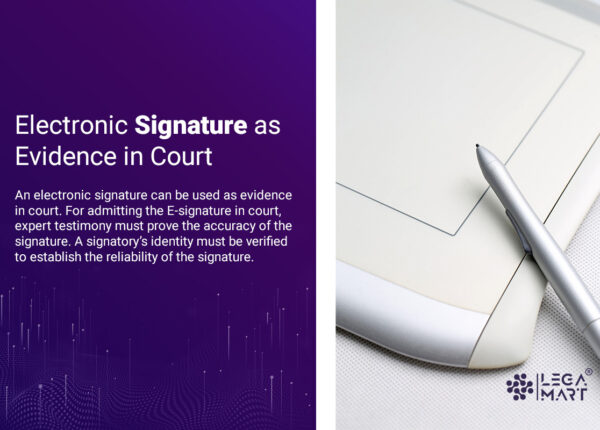
An electronic signature can be used as evidence in court. For admitting the E-signature in court, expert testimony must prove the accuracy of the signature. A signatory’s identity must be verified to establish the reliability of the signature. The following requirement must be met for an e-signature to be admissible in court:
- A digital seal that can track its origins
- An audit trail showing back to the original signer
- Strong authentication methods to confirm signers’ identities
What Are the Legal Concerns with Electronic Signatures?
- I did not sign this document. Disputes often arise due to authentication issues, where one party claims they didn’t electronically sign a document. A well-designed electronic signature system can address this by providing legal ways to prove intent to sign. This may involve following a series of steps, using two or three-step authentication, or ensuring that the signee fully reads the document before proceeding, which serves as valid proof of intent.
- This is not the document I signed. Non-repudiation, where one party denies the validity of a contract, can lead to disputes. To prevent such cases, an electronic signing system should have a robust audit trail, strong documentation, and tracking before and after capturing the signature. This includes generating digital keys and time-stamping to ensure the integrity of the document.
- Proofing Issues. In most cases, digitally signed documents are tamper-proof. The system can detect unauthorized changes, making it challenging for a signee to repudiate their signature. Authentication methods like PINs, passwords, or one-time passwords (OTPs) are strong evidence of approval or agreement.
- I did not see that in the document. Just like paper contracts, transparency is key. Organizations offering contracts should fully disclose all terms and conditions, especially regarding data and privacy. Some laws require specific disclosures for consumer consent, ensuring they understand and can opt out of electronic transactions. Including fillable questions in the contract can help ensure that important disclosures are clear.
Electronic Signature under Various Laws and Regulations
The law is constantly evolving about the enforceability of electronic signatures and the valid execution of contracts. Various legislations and statutes have been passed in different countries which define electronic signatures as stated below:
- Canadian law defines an e-signature under Section 31(1) in The Personal Information Protection and Electronic Documents Act. Digital signatures are characters and numbers generated by users and applied to an electronic document to identify the signer.
- In U.S. law, an e-signature has been defined under Section 106(5) in The Electronic Signatures in Global and National Commerce Act as an electronic symbol associated with the contract and implemented by a person to sign.
- In Indian law, an e-signature has been defined under Section 2(ta) in The Information Technology Act as authentication of any electronic record by a user through an electronic technique, including a digital signature.
- In Chinese law, an e-signature has been defined under Article 2 in The Law of the People’s Republic of China on Electronic Signature as the digital data attached to a data message used for identifying the identity of the person signing the contract and the party’s acceptance of the contents of the message.
Electronic Signatures in the European Union
The first recognition of e-signature was in the Directive on a Community framework for Electronic Signature (eSignature Directive), which was adopted in 1999. Since July 2016, electronic signatures in the EU have been governed through the Electronic Identification and Trust Services (eIDAS) Regulation. This regulation helps in providing a predictable regulatory environment through seamless electronic interactions between businesses, public authorities, and citizens.
EU’s eSignature Building Block
The eSignature building block is used to help public administrations and businesses to accelerate the creation and verification of e-signature. This further facilitates the mutual recognition and cross-border practicality of e-signatures. Therefore, it is possible for businesses and public administrations to use e-signatures within valid and structured EU-interoperable formats. This is a key building block for the European Digital Single Market.
E-signatures can be identified to be the building blocks of the Digital Europe Programme (DIGITAL). These include reusable specifications, software and services that have now become a part of a wide variety of IT systems within the different policy domains of the EU.
What does DIGITAL eSignature offer?
DIGITAL eSignature is inclusive of several services, which are managed by the EU. They are:
- Digital Signature Services (DSS). This is an open-source library which is used for the creation and validation of e-signatures.
- Trusted List Manager. This helps the Member States’ Trusted List Scheme Operators (TLSOs) in the creation of Trusted Lists.
- Technical Specifications and Associated Standards (ETSI). This includes the guidelines for e-signatures and e-seals, as outlined in the eIDAS Regulations.
- DSS Conformance Testing. The service is maintained by ETSI and is mainly used to help service providers and public administrators to conform with the e-signature solutions.
Foreseeable uses of e-signatures in the EU
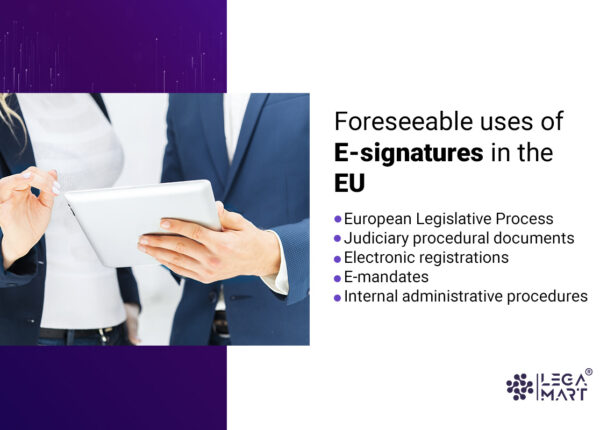
Some examples of inter-institutional, cross-directory or external interactions of e-signatures within the EU are:
- European Legislative Process – may be used to sign legislative, regulatory, or administrative acts.
- Judiciary procedural documents – may be used for court briefs, pleadings, case management and within other similar procedural documents.
- Electronic registrations – for business registries, tax registries, and social security registries.
- E-mandates – may help in easier mandate management by switching from paper to e-mandate systems.
- Internal administrative procedures – used in Human Resources paperwork, e-invoices, and contract management.
E-contracts and E-signatures in a Post-Covid Era
E-contracts have played a significant role during the pandemic. Everything has become online, so people started using technology and digital platforms to conduct business. e-signature can authenticate electronic contracts. Courts have also begun considering the validity of electronic signatures. Many automated tools and websites allow your company to process documents for e-signatures and valid execution of contracts in the post covid era.
Replacement of Wet Ink Signature with E-signatures
Electronic signatures cannot fully replace wet ink signatures since some court documents, such as negotiable instruments or trust deeds, cannot be electronically signed. The world is keeping up with digital technology, and it is only a matter of a few years before e-signatures will be used in almost every contract. Transactions that involve parties from different countries can easily use electronic signatures instead of wet ink signatures.
Conclusion
Electronic signatures and the valid execution of contracts are essential for businesses. Traditional paper contracts have become outdated with the development of electronic signatures and valid execution of contracts in the post covid era. E-contracts and E-signatures are less expensive than other methods since parties don’t have to gather to execute a contract. The whole process of contracts, from offer to acceptance, can happen digitally, saving a lot of time.
Drafting and execution of electronic contracts require expertise, and thus Legamart offers the best solution for your issues in electronic signature and execution of contracts. They have a network of excellent lawyers who can help you get started and provide professional guidance on E-contracts and E-signatures in the Post-Covid Era. You can post your questions or queries on Legamart, and they can resolve your query on the E-signing of a contract providing you 100% satisfaction with your doubts.
Frequently Asked Questions (FAQs)
What is an electronic signature?
They are an alternate way to provide consent or approval for contracts and other documents without wet ink signatures. People can use the digital markup or impression to signify that the individual creating it has agreed to the terms of an agreement in the digital format.
What types of documents can and cannot be signed through electronic signature?
Electronic signatures can be used to sign the following documents:
- Offer letters
- Sales contracts
- Permission slips
- Rental/lease agreements
- Liability waivers
- Financial documents
The following documents cannot be signed with the help of an electronic signature:
- Wills and codicils
- Court orders and notices
- Documents related to a family matter
- Notices regarding cancellation or termination of health insurance benefits
Are e-signatures legally binding?
Yes, they are legally binding in almost all countries. While nuances might exist in every country’s laws, they are generally the same. Consult legal experts for your specific jurisdiction to gain more clarity.

